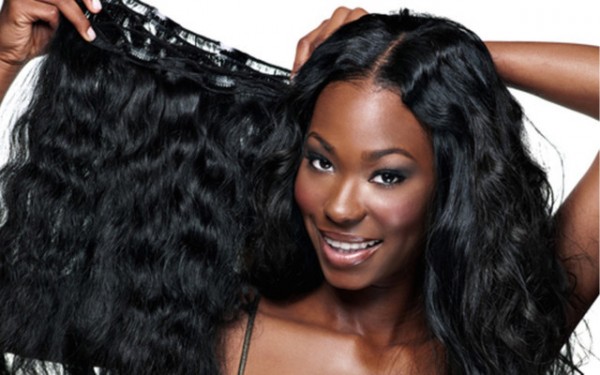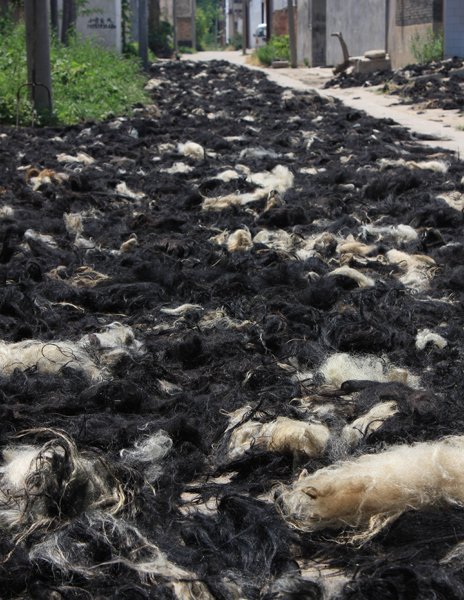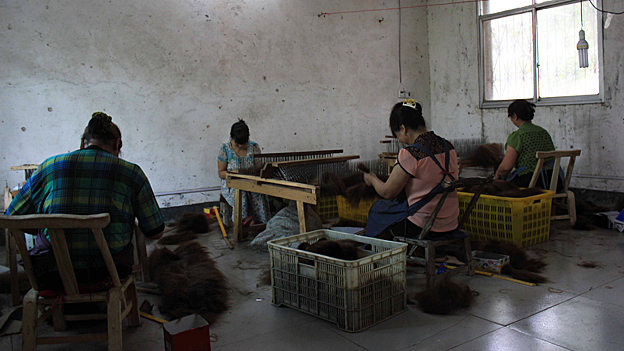I remember when the choice of hair weaves for black women were limited. At the local beauty supply, you would find the obvious synthetic hair, and brands labelled ‘human hair’. But such hair was actually made from synthetic fibers, designed to mimic human hair. Whether this was clever marketing or blatant false advertising, such companies managed to get away with this. Today, with the wealth of hair extensions now available, the choice has definitely improved. Unfortunately, the deceptive marketing still exists.
Asian, Brazilian and Russian hair are well sought after. Many weave wearers envision women in other countries, with hip length hair, going to an organization to sell or donate their hair and have it carefully removed. Many are under this illusion that such hair is handled meticulously with the highest standard of care, before reaching worldwide markets. This couldn’t be further from the reality. Sam Piranty, for his article: the salons that hope you can’t tell goats and humans apart, traveled to China to examine the hair extension industry. He found that most of the hair, produced in Hunan province, is a mixture of human and goat hair. This hair is mainly sold to African clients; including Nigerians, Ghanaians, Congolese and South Africans. He interviewed a Chinese shop owner, who said that such hair use to be sold in Europe and America. “We say it is Indian hair or Brazilian hair, but in fact it is normally Chinese hair or even goat hair. They never realize. This is the only way we can keep things cheap”, said Lilly, a Chinese beauty supply owner.
Riqua Hailes, owner of Just Extensions in Los Angeles and The Weave Express in Washington D.C, traveled to various Asian countries, to see firsthand where the hair comes from. She was prompted to do this after finding inconsistencies in the hair extensions she received from suppliers. She traveled to China, Cambodia, Malaysia and India. She will also be travelling to Brazil and Russia later in the year.
China
Most human hair extensions or weaves are labelled with the names of various countries, indicating the origin. Many women today are choosing to spend more money on weaves, hair extensions and wigs. Rather than buying synthetic hair, which doesn’t last as long and knots easily, many are choosing to invest hundreds of dollars in human hair. When a packet of hair extensions is labelled Brazilian, Malaysian or Indian, people are willing to pay a lot more money for it. Women like the option of curling their weaves, applying heat and wetting the hair. All of which isn’t always possible with cheaper synthetic hair. Manufacturers know that these labels create an image of quality. “Chinese hair is often considered cheap in the extensions industry, because it isn’t donated hair” says Hailes. “So in order to be on the same playing field as other exporters, they will market it as Brazilian or Malaysian hair, which can go for twice the money”.
The hair that comes from China is imported from India. But it is not from women who come forward to donate the hair. Neither is it removed meticulously and stored in the best conditions. It is simply collected shed hair, gathered from the salon floors and, hair brushes. Hair of this kind is referred to as non-Remy hair. “Non-Remy hair is less desirable in the extensions industry. But China collects this hair, cleans it and mislabels it as being from a higher-quality hair extension source like Brazil, Russia or India”, says Hailes. So such hair can come from a number of different people, be gathered from the floor, combs or hair brushes in India or China, and be labeled Brazilian hair.
Production Practices
Another point to remember is that the standards of hygiene in developing countries will not be as strict as they are in Western Countries, like the United States. Strict regulations for how such products are cleaned, stored, transported and produced are unlikely to exist or be enforced. So don’t be taken in by the glossy packaging and the picture on the front. You have no way of knowing for sure what the hair has been exposed to or even where or who it came from. The hair is usually treated with chemicals, the effects of which are unknown until a person has a reaction to them.
In Cambodia, Hailes found women who sold their hair, for as little as $5 to $8. Many felt like they had no choice and were doing it to feed their families. In India thousands of pilgrims visit community temples to donate their hair. Shaving their heads symbolizes washing away the past and a fresh start. Hindus believe sacrificing their hair to the gods will lead to their prayers being answered. Some do this once, while others may do it annually. The hair is auctioned off and some of the money goes towards funding community projects. You may remember seeing images of this in the Chris Rock movie Good Hair. Check the labels of your weaves and hair extensions. If it is labelled Indian, Malaysian or Brazilian but says it is distributed from China, it is probably deceptive. Smell the hair as well, as shed hair will have a smell of acid and silicone.
Malaysia
Upon travelling to Malaysia, she concluded that ‘Malaysian hair’ doesn’t exist. Hair labelled ‘Malaysian’ is typically purchased directly from China. There is unlikely to be one distinct feature of Malaysian or Brazilian hair anyway. Both countries consist of people from different ethnic origins and backgrounds. As a Brazilian person can have African, European or Asian ancestry, what would constitute Brazilian hair? You will find many different hair types there; from Afro-kinky to straight hair. In Malaysia, there are different ethnic groups, including Chinese and Indian, all of which may vary in hair textures. I await her report from her visit to Brazil, but it wouldn’t surprise me if she comes to the same conclusion. The hair is produced and shipped from China, but simply labelled Malaysian or Brazilian, to make it competitive and give the illusion of better quality.
In Conclusion
1. Wash your hair extensions or wigs before use.
The reality is, most hair extensions are produced in countries that do not have the same laws and sanctions for production practice that exist in western countries. To ensure that the hair is clean, gently co-wash it and allow it to air dry before use. If it is human hair and of the quality it claims to be, this should not damage the hair.
2. Read labels
If the hair claims to be from India, Russia or Brazil, check the shipping information. If it was shipped from China, it is likely to be misleading information and is probably hair produced there. Remember that Malaysian hair was found to not exist.
3. Don’t fall for gimmicks
The texture and quality of the hair speak for itself. The shipping information tell you where the hair really came from. Unfortunately, when it comes to hair extensions, you don’t always get what you pay for. Don’t be so quick to part with your money just because clever or even deceptive marketing is used. Hair produced in China is often shed hair collected from brushes and salon floors, labelled to deceived consumers and charge twice as much as it is worth. They are even willing to sell goat hair as human hair. Do not be deceived.
4. Examine your hair extensions closely
Remember to take note of the feel and smell of the hair. Hair that has been put through chemical cleaning will have a harsher texture. It will also have a strong chemical and silicone odor. These are signs of hair that has been produced in China using the practices mentioned previously.
5. Treat weave or extensions as an occasional luxury, not a necessity
No one, who is in good health, should have to depend on weaves or hair extensions. When there is a dependency, there is a certain desperation to have it. Black women fund this industry more than any other group, yet most of this money doesn’t even go to black owned businesses. The growth in the natural hair industry has seen a growth in black owned businesses within the hair and beauty sector. More and more women are learning to love their natural afro textured hair. We are even producing and purchasing wigs, weaves and hair extensions that reflect our natural hair, rather than sourcing Asian or Brazilian hair that may not look as natural on us.
Be sure to check out both articles:
The salons that hope you can’t tell goats and humans apart. http://www.bbc.com/news/magazine-28894757
The real story behind where your hair extensions come from.
https://www.yahoo.com/beauty/the-real-story-behind-where-your-hair-extensions-come-101266901210.html
Were you surprised by this information? Do you trust where you purchase your hair extensions from? Share your thoughts below.



Thanks Chloe! I appreciate the reblog as well. Hopefully more of us will be well informed about this topic. 🙂
LikeLike
Reblogged this on HairNameIsChloe and commented:
We all know protective styling can help..but have you ever actually wondered where your “peruvian” weave came from?
LikeLike
Love this! Such a good article and enlightening!
LikeLike